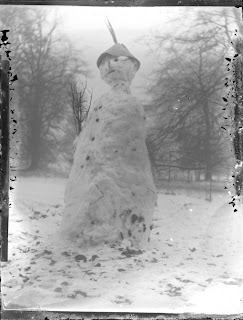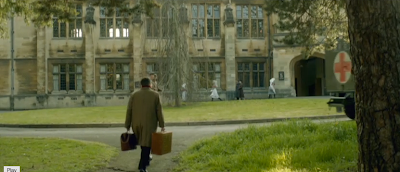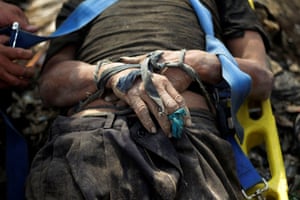In class today: quiz on Tuesday's reading.
Composition: Triangles
Josef Koudelka, Gypsies, “Skeleton boys”

Triangles are one of the best compositional techniques you can use in photography to fill your frame, add balance, and add movement in your images.

The three kids fit in perfect harmony and fill the frame of the shot quite well. Can you find the repeated triangles?
Josef Koudelka, Gypsies, Reclining man
In this shot, you see a man casually lying in his bed, proudly displaying a picture frame and a large metal coin.

What is being repeated?
Josef Koudelka, Gypsies, 3 guys

How is the image framed?
What is the mood of the image?
What is repeated?
Alex Webb, Istanbul, Telephone booth

What are the three different layers?
What unifies the image?
Alex Webb, Istanbul, Kids playing with ball

How is this image appear surreal?
How would the image appear if the ball were left out?
Alex Webb, Cuba, Woman and 3 dogs

How does woman's checkered shirt impact the image?
How do the dogs create a sense of tension? (look closely!)
Eric Kim, Mumbai

Composition: Diagonals
There are 3 types of main lines: the horizontal, vertical, and diagonal line. They also go in degrees of intensity (the horizontal line being the least dynamic and the diagonal line as the most dynamic).
1. The horizontal line
The horizontal line is by nature, flat. If you think about anything in nature that is horizontal — it is at rest and unshakeable. Imagine a man lying on the ground or a tree trunk lying flat on the ground. It is solid — and isn’t going anywhere.
2. The vertical line

The vertical line is much more dynamic than the horizontal line. The horizontal line is going straight up and down– which makes it much more “off-balance.” Imagine anything in nature that is vertical. Trees are tall and powerful, but if they didn’t have strong roots they would be easy to tip over. Skyscrapers which go for hundreds of floors upwards are very unstable, and a earthquake could easily topple them over (versus a flatter structure which is more stable and close to the ground).
Imagine a man standing tall. Would it be easier to tip him over to make him fall? Yes. How about a man lying down (horizontal line). No- the man lying on the ground is stable.
3. The diagonal line

It is the most dynamic of all the three lines. After all, in nature anything that is diagonal is far more unstable than both horizontal things and vertical things. A diagonal line is something literally about to tip over.
Imagine a man standing up, and you shoved him quite hard. He would then start tipping over, making a diagonal line with his body. He is about to topple over– full of dynamic energy and tension.
Henri Cartier-Bresson. ROMANIA. 1975. In a train.

Note the reciprocal diagonal lines.
Where does the photographer want you to focus?
How about triangles?

Form follows content?
OR
Content follows form?
Henri Cartier-Bresson. FRANCE. 1932. Marseille.

Where are the diagonals in this image?
Henri Cartier-Bresson. SPAIN. 1933. Valencia Province. Alicante.

This shot to start off is quite enigmatic. You see three characters in the shot, with the person in the middle being the most prominent. But is the person a man or a woman? The person has masculine features in the face, but looks quite dainty and has perfectly sculpted eyebrows and some eyeliner around the eyes. This is the first big puzzle. Then you have the other two characters in the frame looking a little uneasily at the photographer (HCB) while performing some sort of play with their hands.
The person is transgender, which solves part 1 of the mystery. Part 2, what caused this strange arrangement to come to be? Apparently HCB said all of his photos were unstaged– which actually isn’t true. Anyways, try to draw the diagonal line in the shot. And no- it isn’t perfectly corner-to-corner this time. Still can’t see it? Focus on all the hands that are connecting in the shot.

Now find the triangles.

Henri Cartier-Bresson. FRANCE. 1959. Paris. The Palais Royal Gardens.
Diagonals can also add a strong sense of movement and direction. We will see this well in a shot he took at the Royal Gardens in Paris:

You can easily pick out the diagonals? What serves as a contrast to their motion?
Henri Cartier-Bresson. USA. 1947. Cape Cod, Mass, Independence Day.

Point out the diagonals.
What emotions might be embedded in the woman's hand gesture?

Cornell Capa. USSR. 1958. Moscow. The Bolshoi Ballet School.

Approximately, where do all the diagonal lines intersect?
Composition: Framing
Framing itself is a pretty basic compositional technique and used by photographers to retain focus, energy, and depth in their images.
According to Google, a frame is: A rigid structure that surrounds or encloses something such as a door or window.
In photography, every image we capture is a frame. We decide what to include in the frame and what not to include in the frame. We are selective in terms of what gets include and what doesn’t get included.
For example, whenever taking a photograph of a subject, we have several choices to tell different stories or narratives.
Take a look at the following:

This looks like a man by himself.
Now look at the contact sheet.
How has the narrative changed?
Framing in composition
When it comes to framing a scene, you can also add a compositional technique of adding a frame inside your frame. Having a frame inside your frame adds more focus to your scene– and tells your viewer what to focus on.
In this photo, a man is surfing in the river.

How does the bulls eye frame change the focus?

The frame (of the bulls-eye) gives focus to the photograph. It forces the viewer to look at the surfer in the frame (instead of the biker on the left). And it also gives the uneasy feeling that the surfer is being watched by a sniper — about to shoot him.
Note the similar technique employed here:

How do the geometric shapes contribute to the mood of the photo?
Composition: Perspective
Google defines “perspective” as the following:
Unique perspectives or vantage points make images have different impressions and feelings."The art of drawing solid objects on a two-dimensional surface so as to give the right impression of their height, width, depth, and position in relation to each other when viewed from a particular point."
To make more edgy and interesting photos, try embracing more unique perspectives (shooting from a really low angle, or getting on top of a roof and shooting from a high vantage point).
Low Perspectives

They call it the “superman effect” in which they are photographed from low angles. When you take photos (or video) from people when you are crouching down and looking up– people look much bigger, taller, and powerful than they really are. Actors also often stand on stools or boxes when filming– to further add to this “superman effect.”

extremely low angle
Note how close Gilden got to fill the frame. There is no really empty space under-utilized in the frame — except the negative space of the sky which is necessary to make a stronger contrast against the older woman’s head.
All of these elements make for a well-balanced photograph, with lots of strong geometry in the photo (triangles, circles, and squares).


Note how the low angle accentuates the triangle of the handlebars.


High Perspectives

The high vantage point gives one that wonderful sense of scale. The cars on the bottom are tiny– but visually they don’t feel that far away. And the men in the far right of the frame– also are small silhouettes– but look like giants compared to the tiny cars below.






















